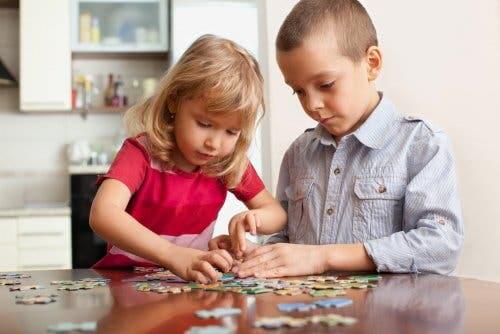All About Psychomotor Development in Kids


Written and verified by the psychologist Ana Couñago
The progressive maturation of the nervous system causes babies to learn and acquire various skills. There are different phases of psychomotor development in children. Then, little by little, kids learn how to have control of their body and movements.
While all children evolve at their own pace, normally they’ll reach all the main milestones of psychomotor development throughout childhood.
Psychomotor development in children
Psychomotor development in children depends on neurological maturation, genetics, and stimulation with the family. In other words, kids grow and develop differently. In this sense, we should also mention that there are certain guidelines that mark the age where kids should acquire certain skills.
This way, parents can be sure that their kids master different motor skills, without being overwhelmed. We can divide them into these two categories:
- Invisible: aspects that are hard to notice at first glance, but are very important in psychomotor development.
- Visible: easily observable achievements with motor skills.

Invisible psychomotor development
The most significant milestones of invisible psychomotor development are:
- Balance. This refers to a set of skills that involve control of posture and moving from one place to another. There are two kinds:
- Static: consists of doing a series of coordinated muscle contractions over time. In fact, a child between the ages of 2 and 5 should be able to balance on one leg. Also, around ages 6 or 7, they should be able to balance with their eyes closed.
- Dynamic: this is being able to move your body in different ways. Children over the age of 4 are able to walk on curved lines.
- Respiratory control. This is being aware of one’s own breathing and being able to control it voluntarily. Also, this is connected to body perception, attention and emotion. Usually, this ability starts to develop around 3 or 4 years.
- Spatial structuring. This is the ability to form relationships between the body, space and other objects. Around 6 years old, kids should be able to distinguish the following basic concepts:
- Orientation: right-left, up-down and front-back.
- Situation: inside-outside and inner-outer.
- Address: from here-from there.
- Distance: far-close and together-apart.
- Temporary structuring. This is having the ability to place actions and routines in time. For this, you have to know how long something takes and order. In fact, learning this is very complex. Also, it takes place from 2 to 12 years old.

Visible psychomotor skills
In visible psychomotor development, there are two categories:
- Gross motor skills. This refers to motor skills that involve control over large muscles, like moving around and posture. So, kids learn these large movements. However, kids start learning them in early childhood, but they perfect them between ages 6 and 8.
- Fine motor skills. This is the ability to do precise and delicate movements with the smallest muscles in the body. In fact, this means you have to have good hand-eye coordination. Kids start to develop these skills in preschool, and improve significantly between ages 5 and 8.
When kids do these actions, you can see their laterality. In other words, you’ll see which side of the body kids prefer for different things, like eyes, hands and feet.
- Right-handed: Consistently using the right eye, hand and foot.
- Left-handed: Does things with the left eye, hand and food.
- Ambidextrous: Uses either side of the body interchangeably to do actions.
- Ambilateral: There’s no conscious preference for any body part when doing an action.
The progressive maturation of the nervous system causes babies to learn and acquire various skills. There are different phases of psychomotor development in children. Then, little by little, kids learn how to have control of their body and movements.
While all children evolve at their own pace, normally they’ll reach all the main milestones of psychomotor development throughout childhood.
Psychomotor development in children
Psychomotor development in children depends on neurological maturation, genetics, and stimulation with the family. In other words, kids grow and develop differently. In this sense, we should also mention that there are certain guidelines that mark the age where kids should acquire certain skills.
This way, parents can be sure that their kids master different motor skills, without being overwhelmed. We can divide them into these two categories:
- Invisible: aspects that are hard to notice at first glance, but are very important in psychomotor development.
- Visible: easily observable achievements with motor skills.

Invisible psychomotor development
The most significant milestones of invisible psychomotor development are:
- Balance. This refers to a set of skills that involve control of posture and moving from one place to another. There are two kinds:
- Static: consists of doing a series of coordinated muscle contractions over time. In fact, a child between the ages of 2 and 5 should be able to balance on one leg. Also, around ages 6 or 7, they should be able to balance with their eyes closed.
- Dynamic: this is being able to move your body in different ways. Children over the age of 4 are able to walk on curved lines.
- Respiratory control. This is being aware of one’s own breathing and being able to control it voluntarily. Also, this is connected to body perception, attention and emotion. Usually, this ability starts to develop around 3 or 4 years.
- Spatial structuring. This is the ability to form relationships between the body, space and other objects. Around 6 years old, kids should be able to distinguish the following basic concepts:
- Orientation: right-left, up-down and front-back.
- Situation: inside-outside and inner-outer.
- Address: from here-from there.
- Distance: far-close and together-apart.
- Temporary structuring. This is having the ability to place actions and routines in time. For this, you have to know how long something takes and order. In fact, learning this is very complex. Also, it takes place from 2 to 12 years old.

Visible psychomotor skills
In visible psychomotor development, there are two categories:
- Gross motor skills. This refers to motor skills that involve control over large muscles, like moving around and posture. So, kids learn these large movements. However, kids start learning them in early childhood, but they perfect them between ages 6 and 8.
- Fine motor skills. This is the ability to do precise and delicate movements with the smallest muscles in the body. In fact, this means you have to have good hand-eye coordination. Kids start to develop these skills in preschool, and improve significantly between ages 5 and 8.
When kids do these actions, you can see their laterality. In other words, you’ll see which side of the body kids prefer for different things, like eyes, hands and feet.
- Right-handed: Consistently using the right eye, hand and foot.
- Left-handed: Does things with the left eye, hand and food.
- Ambidextrous: Uses either side of the body interchangeably to do actions.
- Ambilateral: There’s no conscious preference for any body part when doing an action.
All cited sources were thoroughly reviewed by our team to ensure their quality, reliability, currency, and validity. The bibliography of this article was considered reliable and of academic or scientific accuracy.
- Conde, J. L. y Viciana, V. (1997). Fundamentos para el desarrollo de la motricidad en edades tempranas. Málaga: Aljibe.
- Magnato-Mateo, C. y Sáez-Cruz, S. (2010). Desarrollo físico y psicomotor en la etapa infantil. San Sebastián: Facultad de Psicología.
This text is provided for informational purposes only and does not replace consultation with a professional. If in doubt, consult your specialist.








